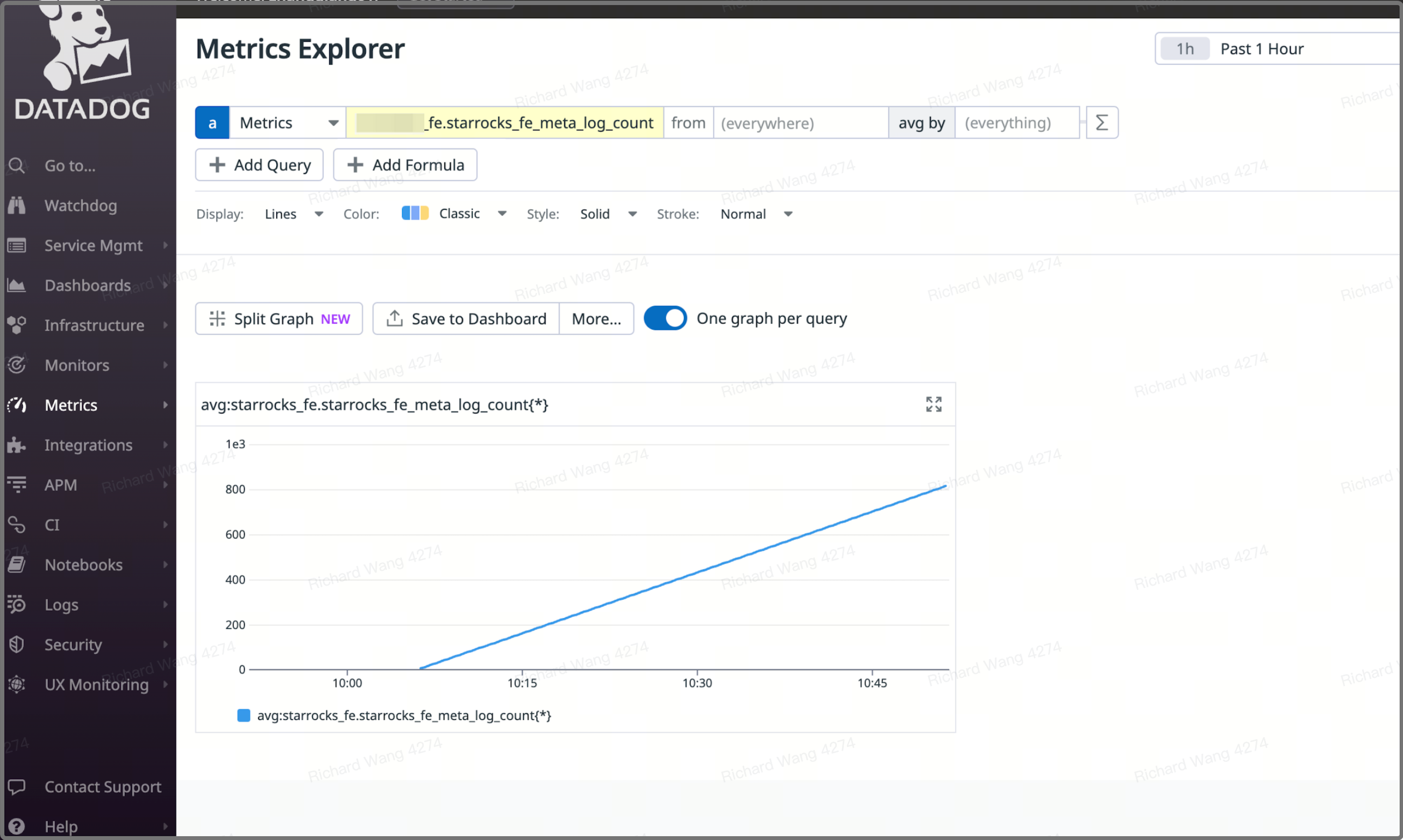Integrate DataDog via Terraform
DataDog is a monitoring and security platform for cloud-scale applications. It provides real-time visibility into servers, databases, applications, and services. You can use DataDog to track the performance of your CelerData Cloud BYOC clusters, identify bottlenecks, and ensure optimal operation, thereby maintaining the health and efficiency of the cluster.
CelerData supports integrating DataDog with your CelerData cluster by installing the DataDog Agent via Terraform. You can follow these steps to install the DataDog Agent:
Step 1: Prepare and upload script
To install the DataDog Agent for a CelerData cluster, you must first prepare the script file that installs the Agent, and upload the script to the S3 bucket on which all EC2 instances that host the CelerData cluster have the required read or write permissions. For more information on running scripts in CelerData, see Run Scripts.
-
Prepare the DataDog Agent installation script
install_datadog.sh:on_deployment_completed() {
# Replace <YOUR_DD_KEY> with your DataDog API key.
# Replace <YOUR_DD_SITE> with your DataDog site URL.
DD_API_KEY=<YOUR_DD_API_KEY> DD_SITE="<YOUR_DD_SITE>" bash -c "$(curl -L https://s3.amazonaws.com/dd-agent/scripts/install_script_agent7.sh)"
if [ "$STARROCKS_INSTANCE_TYPE" = "FE" ]; then
fe_config='
init_config:
instances:
- openmetrics_endpoint: http://127.0.0.1:8030/metrics
# Repleace <fe_metric_namespace> with the namespace you want to use for FE/Coordinator Node metrics.
namespace: <fe_metric_namespace>
metrics:
- starrocks.*
'
sudo bash -c "echo '$fe_config' > /etc/datadog-agent/conf.d/openmetrics.d/conf.yaml"
elif [ "$STARROCKS_INSTANCE_TYPE" = "BE" ]; then
be_config='
init_config:
instances:
- openmetrics_endpoint: http://127.0.0.1:8040/metrics
# Repleace <be_metric_namespace> with the namespace you want to use for BE/Compute Node metrics.
namespace: <be_metric_namespace>
metrics:
- starrocks.*
'
sudo bash -c "echo '$be_config' > /etc/datadog-agent/conf.d/openmetrics.d/conf.yaml"
else
echo "UNKNOWN INSTANCE TYPE: $STARROCKS_INSTANCE_TYPE"
exit 1
fi
sudo systemctl stop datadog-agent
sudo systemctl start datadog-agent
}You must specify the following parameter in the script:
Parameter Description YOUR_DD_API_KEY Your DataDog API key. YOUR_DD_SITE Your DataDog site URL. fe_metric_namespace The namespace for FE/Coordinator Node metrics. It is recommended to set this parameter in the format cluster_name + xxx + feto allow you to identify the metrics easily. Example:celerdata_test_fe.be_metric_namespace The namespace for BE/Compute Node metrics. It is recommended to set this parameter in the format cluster_name + xxx + feto allow you to identify the metrics easily. Example:celerdata_test_be. -
Upload
install_datadog.shto the S3 bucket whose read permissions were granted to the EC2 instances that host your CelerData cluster.
Step 2: Install Agent via Terraform
After uploading the file(s) to S3, you can install the DataDog Agent by running the script while deploying the cluster.
-
Declare
install_datadog.shin thecelerdatabyoc_classic_clusterorcelerdatabyoc_elastic_clusterresource used to deploy your CelerData cluster.The following example shows only the script-related arguments in a
celerdatabyoc_classic_clusterresource. For detailed information on other arguments, seecelerdatabyoc_classic_clusterandcelerdatabyoc_elastic_cluster.resource "celerdatabyoc_classic_cluster" "cluster-with-datadog" {
...
init_scripts {
// Replace <path_to_script_logs> with a directory for the script log storage.
logs_dir = "<path_to_script_logs>"
// Replace <path_to_install_datadog.sh> with the S3 URI of install_datadog.sh.
script_path = "<path_to_install_datadog.sh>"
}
run_scripts_parallel = false
...
}You must specify the following argument in the resource:
Parameter Description path_to_script_logs The S3 path used to store the logs of your scripts. The S3 path is in one of the following formats: s3://<bucket_name>/<folder_name>/: You must go to the instance profiles associated with the EC2 instances to which the CelerData cluster will be deployed and configure read and write permissions on the specified bucket.s3a://<bucket_name>/<folder_name>/: You must go to the instance profiles associated with the EC2 instances to which the CelerData cluster will be deployed and configure read and write permissions on the specified bucket./<folder_name>/: You can use this format if you want the logs to be stored in the bucket you use for the cluster deployment.
Tip
It is recommended to specify this argument as the parent directory ofinstall_datadog.sh.
path_to_install_datadog.sh The S3 URI of install_datadog.sh. The S3 URI is in one of the following formats:s3://<bucket_name>/<folder_name>/install_datadog.sh: You must go to the instance profiles associated with the EC2 instances to which the CelerData cluster will be deployed and configure read permissions on the specified bucket.s3a://<bucket_name>/<folder_name>/install_datadog.sh: You must go to the instance profiles associated with the EC2 instances to which the CelerData cluster will be deployed and configure read permissions on the specified bucket./<folder_name>/install_datadog.sh: You can use this format ifinstall_datadog.shis stored in the bucket you use for the cluster deployment.
-
Apply the resource.
terraform apply
If you have installed the DataDog Agent successfully, you will find the metrics of your CelerData cluster on the Metrics Explorer page of your DataDog site. For the detailed descriptions of the metrics supported, refer to StarRocks Monitoring Metrics.
